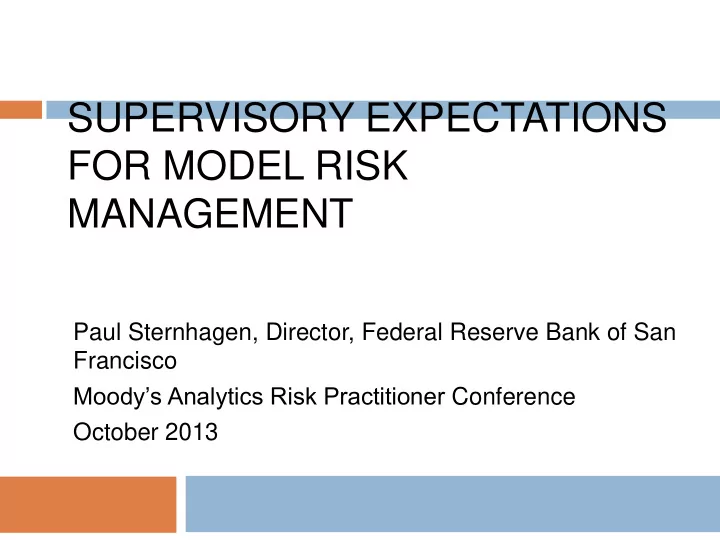

SUPERVISORY EXPECTATIONS FOR MODEL RISK MANAGEMENT Paul Sternhagen, Director, Federal Reserve Bank of San Francisco Moody’s Analytics Risk Practitioner Conference October 2013
Purpose/Background 2 In 2011, OCC & Federal Reserve issued Model Risk Management Guidance (MRMG) Focused on all aspects of model risk management Model validation at the core, but underscores that other aspects are also important Supported by developers/users, controls/compliance Rationale and context Principle-based, applies to variety of model uses: Credit, Market, Compliance Discusses key features/practices supervisors have observed Benefited from review of bank policies & practices Consistent with principles applied during bank examinations Includes industry and supervisory developments (Basel II, stress testing) Guidance outlines a “framework” for banks and supervisors to evaluate model risk management
Key Sections of MRMG 3 OCC Bulletin 2011 – 12 Federal Reserve SR Letter 11-7 Introduction I. Purpose and Scope II. Overview of Model Risk Management III. Model Development, Implementation, and Use IV. Model Validation V. Governance, Policies, and Controls VI. Conclusion VII. Highlights three key areas of responsibility Developers, users, owners Staff conducting validation activities Control groups and internal audit FDIC supports content of MRMG and also expects firms to have sound MRM practices
Overview – Some Definitions 4 What do you mean by “model”? Produces quantitative estimate (of an uncertain value) Three components: Input, processing, reporting Inevitably, intentionally simplified representations of the real world What do you mean by “model risk”? Potential adverse consequences from decisions based on models that are incorrect or misused Includes financial loss, poor decisions, damage to reputation Sources of model risk? Model flaws: Errors in model components Model misuse: Comes from not understanding model limitations and/or applying existing model to new products, markets, behaviors Role of “independence”? Validation involves a degree of independence from development & use Can be supported by independent reporting lines but other ways to do this Simply having independence on the org chart does not suffice
Overview – Some Principles 5 Apply familiar risk management techniques Identify the source of risk Assess the magnitude of the risk (quantifying where possible) Manage the risk: Mitigate, control, limit, monitor Materiality plays an important role Effective challenge Critical analysis by objective, informed parties who can identify model limitations and assumptions and produce appropriate changes Incentives: Separation from development; also affected by compensation practices, performance evaluation criteria, corporate culture Competence: Technical knowledge to formulate critique and institutional knowledge of line of business Influence: Ensure appropriate actions are taken Model risk cannot be eliminated so must be managed Limits on model use, monitor model performance and usage Adjust models over time, supplement with other analysis and information Important to manage both individual and aggregate model risk
Overview – Role of Governance 6 Strong involvement of board & senior management Having good models is not enough There needs to be proper oversight, including over use of model output Policies and procedures that are comprehensive & current Roles and responsibilities Ownership Controls Compliance Internal audit Assess overall effectiveness of model risk management framework Verify compliance with policy by owners and control staff Model inventory, timely validation work, model limits, systems Importance of documentation – required for credible validation
Observations on MRMG Implementation 7 Guidance has been in effect for two years Supervisors have been working with firms on guidance implementation, responding to questions individually and collectively Supervisors recognize that putting in place a sound MRM framework takes time & effort – looking for progress and improving trends Some identified areas of progress, but also continuing challenges General observations Most firms have responded favorably to MRMG, recognizing that it contributes to overall good risk management Many firms recognize that MRM is not a quick “fix” and that it takes time, energy & resources to get things right Not just smaller firms that are facing issues with implementing MRM Most firms “have a plan” to reach MRM steady state, but not there yet
MRM for Stress Tests 8 Given the limited empirical data to develop and support stress testing models, the focus of validation activities is slightly different than what is observed for models calibrated to baseline economic conditions Key model validation elements such as conceptual soundness, sensitivity analysis, and benchmarking become more important considerations to effectively challenge the relative impact of the model outcome and evidence acceptable model performance Ongoing monitoring of the model is also key, as economic conditions evolve to previously unobserved environments for which the models have not been employed Backtesting, a key tool in many validations, becomes more difficult to complete effectively, given the limited relevant data Evaluating the expert judgment employed can assume heightened importance during effective challenge
MRM Governance for Stress Tests 9 The communication of the independent conclusions, including weaknesses and limitations, uncovered in the validation efforts is a key consideration in the effectiveness of validation for stress tests Stress test validation should align with the firm’s existing model governance processes. These include: A comprehensive model validation policy that includes requirements related to stress testing models Identification of models Consistent application of risk assessment/tiering criterion A centralized governance and control process Review and approval by governing body A process for escalation, tracking, and resolution of issues identified in the model validation process Guidelines for use of stress test model output Internal Audit’s assessment of MRM should also cover stress tests
Other Observations on Implementing MRM 10 Definition of “model” not always clear/consistent – too narrow? And not all firms gauge materiality of models and the differing consequences While most firms have in place policies and main elements of governance, they are still in the process of evaluating their models Some policies do not require validation before a model is put into production The three elements of effective challenge are not always evident Documentation continues to be a challenge, especially for model development and validation reports Have been some observed shortcomings in how model results are displayed and reported, including model limitations and uncertainties Validating vendor models presents certain challenges Firms should avoid having a “checklist” mentality for MRM
Recommend
More recommend